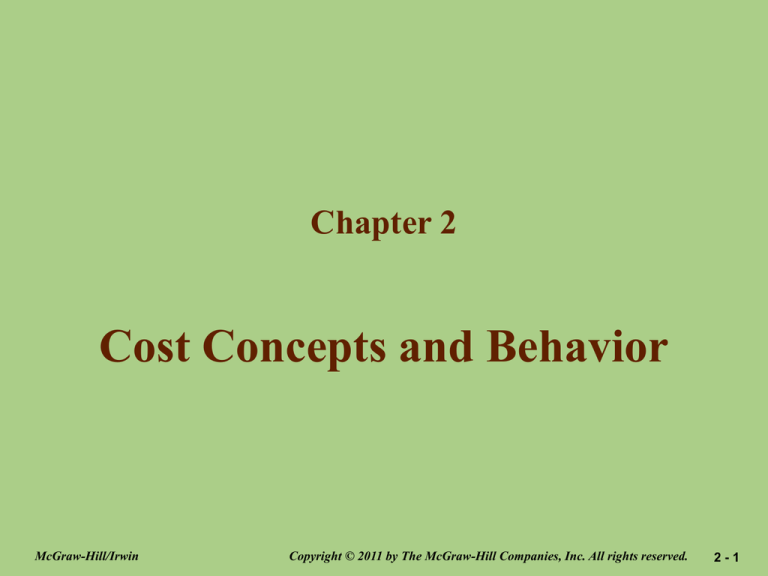
Chapter 2
Cost Concepts and Behavior
McGraw-Hill/Irwin
Copyright © 2011 by The McGraw-Hill Companies, Inc. All rights reserved.
2-1
What is a Cost?
L.O. 1 Explain the basic concept of “cost.”
• Cost is a sacrifice of resources.
2-2
LO1
Cost versus Expenses
Cost
Outlay Cost
Past, present,
or future cash
outflow
Opportunity Costs
Forgone benefit from
the best alternative
course of action
Expense
Cost charged against
revenue in an
accounting period
2-3
Presentation of Costs
in Financial Statements
L.O. 2 Explain how costs are presented in financial statements.
Income Statements
Service company
–
=
–
=
Revenues
Cost of services sold
Gross margin
Marketing and
administrative costs
Operating profit
Cost of
billable
hours
The excess of operating revenue over costs
necessary to generate those revenues
2-4
LO2
Presentation of Costs
in Financial Statements
Income Statements
Merchandising company
Revenues
– Cost of goods sold
= Gross margin
– Marketing and
administrative costs
= Operating profit
Expense assigned
to products sold
during a period
The excess of operating revenue over costs
necessary to generate those revenues
2-5
LO2
Presentation of Costs
in Financial Statements
Cost incurred to manufacture
the product sold
Income Statements
Manufacturing company
Product costs recorded as
“inventory” when cost is incurred
Period costs recorded as
an expense in the period
the cost is incurred
–
=
–
=
Sales revenue
Cost of goods sold
Gross margin
Marketing and
administrative costs
Operating profit
Expensed
when sold
2-6
LO2
Direct and Indirect
Manufacturing Costs
Direct costs:
Costs that, for a reasonable cost, can
be directly traced to the product.
Direct materials:
Materials directly
traceable to the product
Direct labor:
Work directly traceable to
transforming materials
into the finished product
2-7
LO2
Direct and Indirect
Manufacturing Costs
Indirect costs:
Costs that cannot reasonably
be directly traced to the product.
Manufacturing overhead:
All production costs except
direct materials and direct labor.
Indirect materials
Indirect labor
Other indirect costs
2-8
LO2
Prime Costs and
Conversion Costs
Prime costs:
The “primary” costs
of the product
Conversion costs:
Costs necessary to
“convert” materials
into a product
Direct
materials
Direct
labor
Direct
labor
Manufacturing
overhead
2-9
Cost Allocation
L.O. 3 Explain the process of cost allocation.
• It is the process of assigning indirect costs
to products, services, business units, etc.
2 - 10
Details of Manufacturing
Cost Flows
L.O. 4 Understand how material, labor, and overhead costs are
added to a product at each stage of the production process.
• Product costs are recorded in inventory when costs are incurred.
• A manufacturing company has three inventory accounts:
1. Raw Materials Inventory:
Materials purchased to make a product
2. Work-in-Process Inventory:
Products currently in the production process,
but not yet completed
3. Finished Goods Inventory:
Completed products that have not yet been sold
2 - 11
LO4
Direct Materials
Inventory
Beg. RM inventory
+ Purchases
= Raw materials
available for
production
–
Ending RM inventory
= Raw materials
transferred to WIP
Inventory Accounts
– The Balance Sheet
Work-in-Process
Inventory
Beg. WIP inventory
Finished Goods
Inventory
Beg. FG inventory
+ Direct materials
transferred from
raw materials
+ Cost of goods
completed and
transferred from WIP
+ Direct labor
= Goods available
for sale
+ Manufacturing overhead
= Total manufacturing costs
= Ending FG inventory
= Ending WIP inventory
– Cost of goods sold
– Costs of goods completed
and transferred to
finished goods (or cost of
goods manufactured
To the Income
Statement
2 - 12
Cost Behavior
L.O. 5 Define basic cost behaviors, including fixed,
variable, semivariable, and step costs.
Cost behavior:
How costs respond to a change in
activity level within the relevant range
Relevant range:
Activity levels within which a given total fixed
cost or unit variable cost will be unchanged
2 - 13
Components of Product Costs
L.O. 6 Identify the components of a product’s costs.
Full cost:
The sum of all costs of manufacturing
and selling a unit of the product
Full absorption cost:
The sum of all variable and fixed costs
of manufacturing a unit of the product
Variable cost:
The sum of all variable costs of manufacturing
and selling a unit of the product
2 - 14
LO6
Components of Product Costs
Direct materials = $8
Full absorption
cost per unit
= $29
Full cost
per unit
= $40
Direct labor = $7
Variable manufacturing
overhead = $8
Fixed manufacturing
overhead = $6
Variable marketing and
administrative costs = $4
Variable
manufacturing
cost = $23
Unit
variable
cost = $27
Variable
marketing and
administrative
costs = $4
Fixed marketing and
administrative costs = $7
2 - 15
Making Cost Information Useful
L.O. 7 Understand the distinction between financial
and contribution margin income statements.
Full absorption costing:
• Required by GAAP
• Used for:
– Financial purposes
– External reporting
Sales revenue
– Cost of goods sold
= Gross margin
Variable costing:
• Used for:
– Managerial purposes
– Internal decision
making
Sales revenue
– Variable costs
= Contribution margin
2 - 16
End of Chapter 2
McGraw-Hill/Irwin
Copyright © 2011 by The McGraw-Hill Companies, Inc. All rights reserved.






